在现代的Web应用程序开发中,跨域资源共享(Cross-Origin Resource Sharing, CORS)问题是开发者经常遇到的一个挑战。特别是当前端和后端服务部署在不同的域名或端口时,CORS问题就会显得尤为突出。在这篇博客中,我们将深入探讨如何在 .NET WebService 中解决CORS问题,帮助开发者顺利实现跨域请求。
一、CORS问题描述
在Web应用中,浏览器安全机制通常会阻止来自不同域的请求,这被称为“同源策略”。同源策略允许同一来源(协议、主机和端口相同)的资源相互访问,但会阻止不同来源的资源访问。这种机制虽然提高了安全性,但在实际开发中,前端和后端通常会部署在不同的服务器上,这就引发了CORS问题。
举个例子,当你试图从 http://frontend.com 发送一个请求到 http://api.backend.com 时,浏览器会拦截这个请求并抛出一个CORS错误:
Access to XMLHttpRequest at 'http://api.backend.com/resource' from origin 'http://frontend.com' has been blocked by CORS policy: No 'Access-Control-Allow-Origin' header is present on the requested resource.
对于 .NET WebService ,如果前端应用尝试从另一个域名访问服务,而服务端没有适当的CORS策略,那么浏览器会阻止这些请求并显示该跨域错误。
二、CORS问题代码示例
为了更好地理解CORS问题及其解决方案,让我们先创建一个简单的前后端交互的.NET WebService示例。
1. 后端WebService接口代码
首先,创建一个新的 .NET Framework 项目。你可以使用 Visual Studio 或者命令行工具(如 dotnet CLI )来创建项目。在项目中,我们定义一个 .asmx 文件,并在 .asmx.cs 文件里创建一个接口。
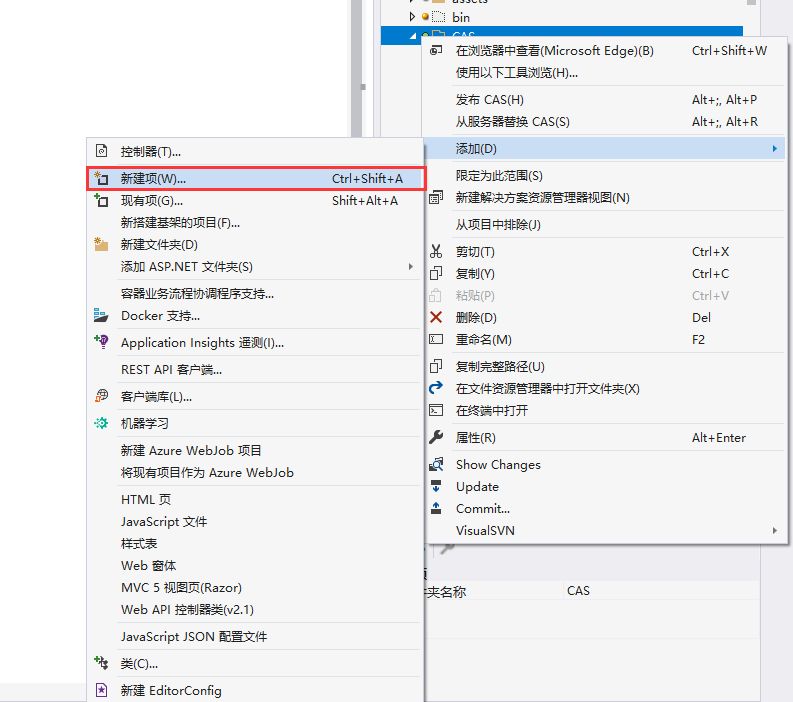
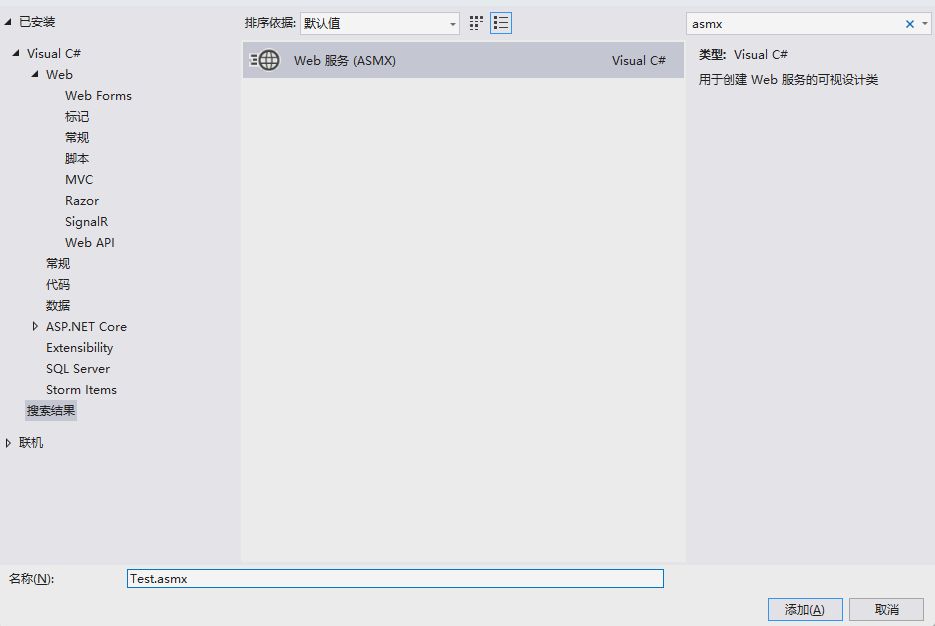
代码如下:
| using Newtonsoft.Json; | |
| using System; | |
| using System.Collections.Generic; | |
| using System.Data; | |
| using System.Web; | |
| using System.Web.Services; | |
| namespace TestProject | |
| { | |
| [WebService(Namespace = "http://tempuri.org/")] | |
| [WebServiceBinding(ConformsTo = WsiProfiles.BasicProfile1_1)] | |
| [System.ComponentModel.ToolboxItem(false)] | |
| [System.Web.Script.Services.ScriptService] | |
| public class Test : WebService | |
| { | |
| [WebMethod] | |
| public void GetJsonData() | |
| { | |
| string json = "{\"MapPoints\":[{\"Coordinates\":[\"118.87220827635\",\"34.885061248714\"],\"Speed\":\"45.7\",\"Time\":\"2024-05-13T13:02:09\"}]}"; | |
| HttpContext.Current.Response.ContentType = "application/json"; | |
| HttpContext.Current.Response.Write(json); | |
| } | |
| } | |
| } |
这个控制器有一个GET方法,当请求 http://localhost:80/Test.asmx/GetJsonData 时,它会返回一个串JSON数据。
这里我们可以用 Postman 测试代码,正确返回结果,则验证后端接口代码没有问题。
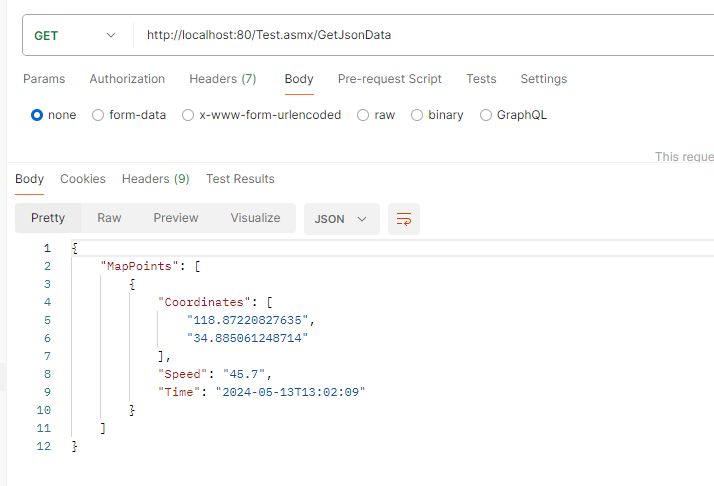
2. 前端接口请求代码
这里我使用的前端访问接口的JavaScript代码是基于 axios 实现的。
| <html lang="en"> | |
| <head> | |
| <meta charset="UTF-8"> | |
| <meta name="viewport" content="width=device-width, initial-scale=1.0"> | |
| <title>CORS Test</title> | |
| </head> | |
| <body> | |
| <h1>CORS Test</h1> | |
| <button id="fetchDataButton">Fetch Data</button> | |
| <script src="https://cdn.jsdelivr.net/npm/axios/dist/axios.min.js"></script> | |
| <script> | |
| document.getElementById('fetchDataButton').addEventListener('click', function () { | |
| getCarLocation(); | |
| }); | |
| function getCarLocation() { | |
| axios.get('http://localhost:80/Test.asmx/GetJsonData') | |
| .then(function (response) { | |
| console.log('Success:', response.data); | |
| }) | |
| .catch(function (error) { | |
| console.error('Error:', error); | |
| }); | |
| } | |
| </script> | |
| </body> | |
| </html> |
页面效果图如下:
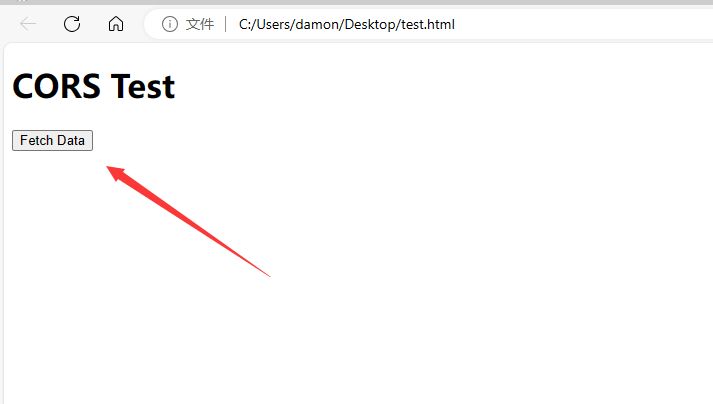
当点击 Fetch Data 按钮时,页面会访问 http://localhost:80/Test.asmx/GetJsonData 接口,并输出返回值到F12控制台日志里。
此时,如果我们不配置CORS,那么请求会被拦截,并报错:
Access to XMLHttpRequest at 'http://localhost:80/Test.asmx/GetJsonData' from origin 'http://localhost:8080' has been blocked by CORS policy: No 'Access-Control-Allow-Origin' header is present on the requested resource.
三、CORS配置详细步骤
为了让我们的 WebService 支持跨域请求,我们需要在项目中配置CORS。在 .NET Framework 中,我们可以通过如下步骤来配置CORS。
1. 配置Global.asax全局请求头参数
创建或打开项目的 Global.asax 文件,找到或添加 Application_BeginRequest() 方法,添加响应头参数,其中 <"Access-Control-Allow-Origin", "*"> 这个响应头是最重要的。
| namespace TestProject | |
| { | |
| public class Global : System.Web.HttpApplication | |
| { | |
| protected void Application_BeginRequest() | |
| { | |
| HttpContext.Current.Response.AddHeader("Access-Control-Allow-Origin", "*"); | |
| HttpContext.Current.Response.AddHeader("Access-Control-Allow-Methods", "GET, POST, OPTIONS"); | |
| HttpContext.Current.Response.AddHeader("Access-Control-Allow-Headers", "Content-Type, Accept, Authorization, X-Requested-With"); | |
| if (HttpContext.Current.Request.HttpMethod == "OPTIONS") | |
| { | |
| HttpContext.Current.Response.AddHeader("Access-Control-Max-Age", "86400"); | |
| HttpContext.Current.Response.StatusCode = 204; | |
| HttpContext.Current.Response.End(); | |
| } | |
| } | |
| } | |
| } |
要非常注意的是,每个请求头参数只能添加一次,如果重复添加,依然会访问报错,可以排查一下 web.config 文件或者专门的路由模块有没有已经添加,或者再每次添加之前判断当前请求头是否已经存在,如果存在删除在添加。
2. 创建自定义HTTP模块并注册
在 .NET Framework 中,通过自定义 HTTP 模块修改 HTTP 响应头,可以协助处理跨域问题。
我们右键解决方案,新建项目,创建 CustomHttpModules 模块。
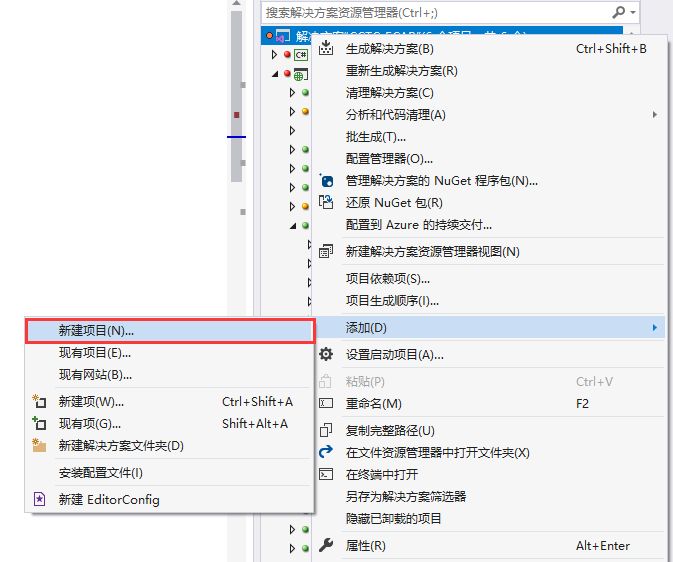
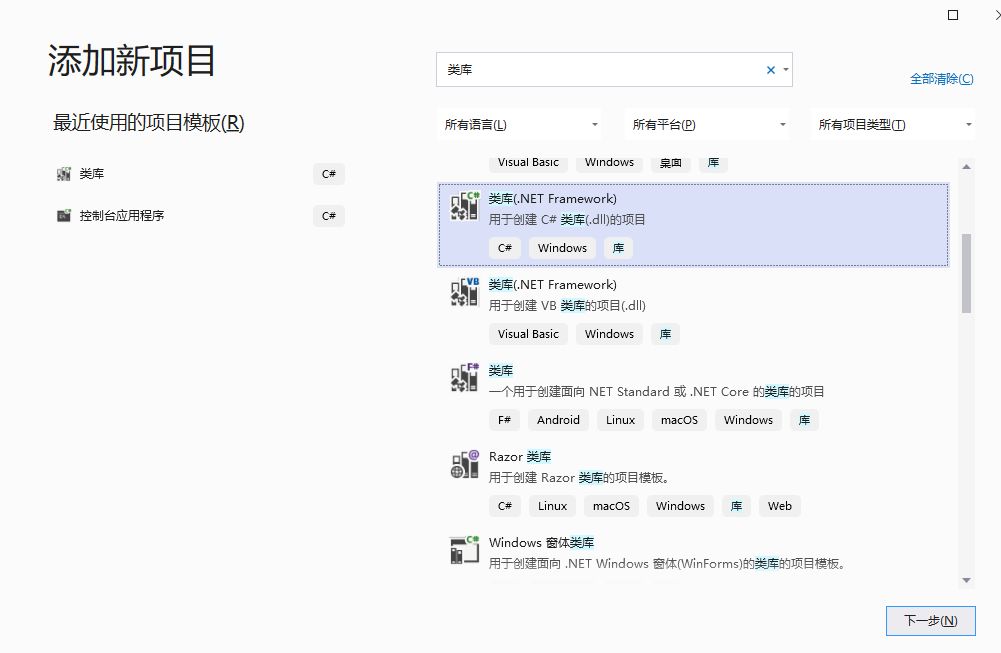
模块内创建 HeaderFilterHttpModule.cs 文件。

代码如下 :
| using System; | |
| using System.Web; | |
| namespace CustomHttpModules | |
| { | |
| public class HeaderFilterHttpModule : IHttpModule | |
| { | |
| public void Init(HttpApplication context) | |
| { | |
| context.PreSendRequestHeaders += OnPreSendRequestHeaders; | |
| } | |
| public void Dispose() | |
| { } | |
| void OnPreSendRequestHeaders(object sender, EventArgs e) | |
| { | |
| try | |
| { | |
| HttpApplication app = sender as HttpApplication; | |
| if (app != null && app.Context != null && app.Context.Response != null) | |
| { | |
| var headers = app.Context.Response.Headers; | |
| if (headers != null) | |
| { | |
| headers.Remove("Server"); | |
| headers.Remove("X-AspNet-Version"); | |
| headers.Remove("X-AspNetMvc-Version"); | |
| headers.Remove("X-Frame-Options"); | |
| headers.Remove("X-Powered-By"); | |
| // 添加CORS相关的头信息 | |
| headers.Add("Access-Control-Allow-Origin", "*"); | |
| headers.Add("Access-Control-Allow-Methods", "GET, POST, PUT, DELETE, OPTIONS"); | |
| headers.Add("Access-Control-Allow-Headers", "Content-Type, Accept"); | |
| } | |
| } | |
| } | |
| catch (Exception ex) | |
| { | |
| // 记录异常 | |
| } | |
| } | |
| } | |
| } |
创建完成后,我们到主项目注册这个自定义的 HTTP 模块。
打开 web.config 文件,找到 <configuration> 下的 <system.webServer> 标签,引入我们刚刚创建好的 HeaderFilterHttpModule 模块。
| <configuration> | |
| <system.webServer> | |
| <modules> | |
| <add name="HeaderFilterHttpModule" type="CustomHttpModules.HeaderFilterHttpModule" /> | |
| </modules> | |
| </system.webServer> | |
| </configuration> |
3. 测试增加CORS配置后的代码
添加上述有关CORS的配置后,我们重新启动 .NET Framework 项目,通过测试页面点击 Fetch Data 按钮,给 http://localhost:80/Test.asmx/GetJsonData 接口发送请求。
可以看到我们得到了正确的返回值。
| { | |
| "MapPoints": [ | |
| { | |
| "Coordinates": [ | |
| "118.87220827635", | |
| "34.885061248714" | |
| ], | |
| "Speed": "45.7", | |
| "Time": "2024-05-13T13:02:09" | |
| } | |
| ] | |
| } |
.NET WebService 跨域CORS问题完美解决。
四、问题解决总结
通过配置 global.asax 全局文件,创建和注册自定义 HTTP 模块,我们成功地解决了 .NET WebService 中的 CORS 问题。这种方法的关键在于拦截和修改 HTTP 响应头,添加必要的 CORS 头信息。总结如下:
- 修改Global.asax文件:修改
Application_BeginRequest方法,修改全局请求头参数。 - 创建自定义 HTTP 模块:实现
IHttpModule接口,并在PreSendRequestHeaders事件中添加或移除 HTTP 头信息。 - 注册 HTTP 模块:在
Web.config文件中注册自定义的 HTTP 模块。 - 测试能否跨域:通过前端发送跨域请求来验证 CORS 配置是否正确。
通过这些步骤,开发者可以有效地解决跨域资源共享问题,确保前后端服务的顺畅通信。在实际开发中,根据具体项目的需求,CORS 配置可能会有所不同,但核心思想和步骤是类似的。希望这篇博客能为你解决 CORS 问题提供有价值的帮助。